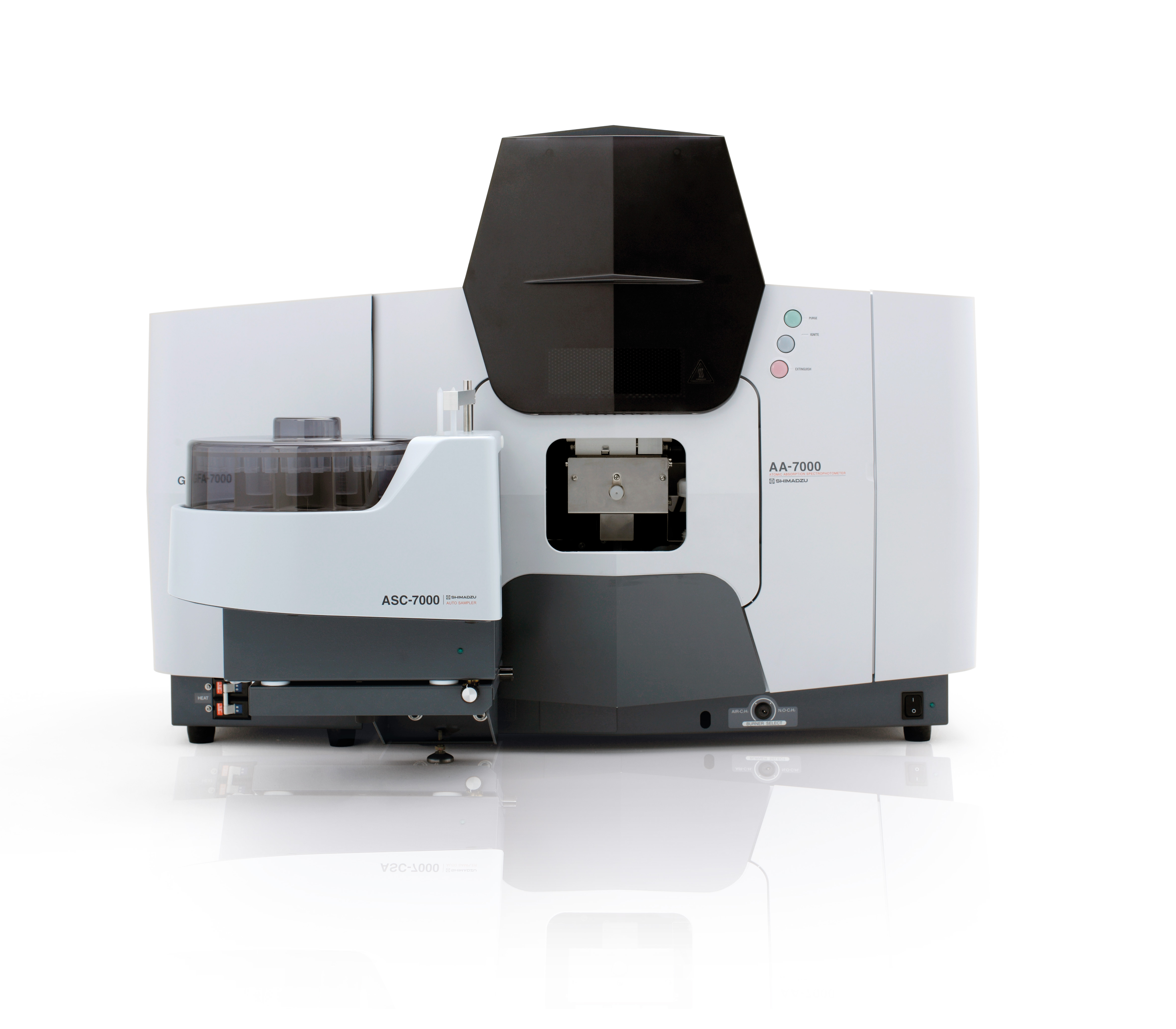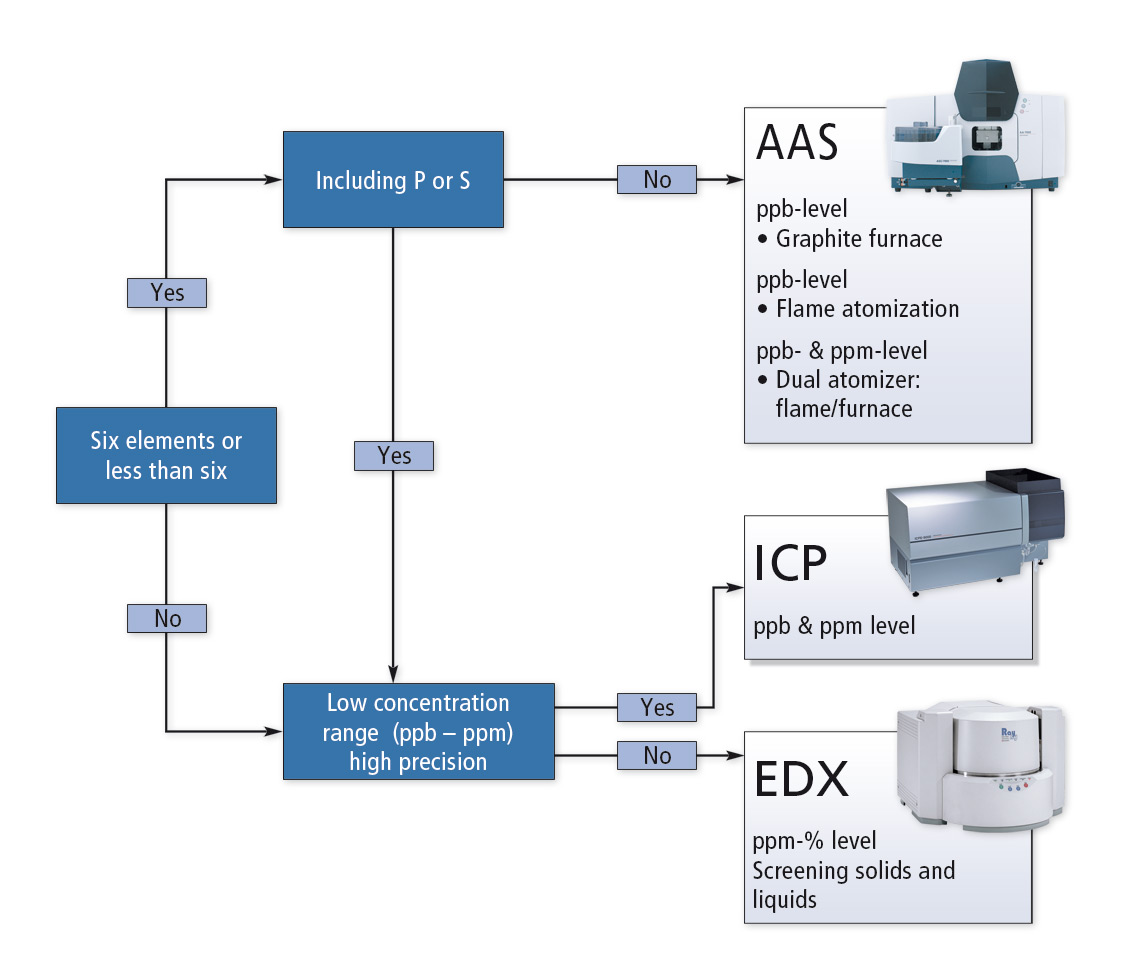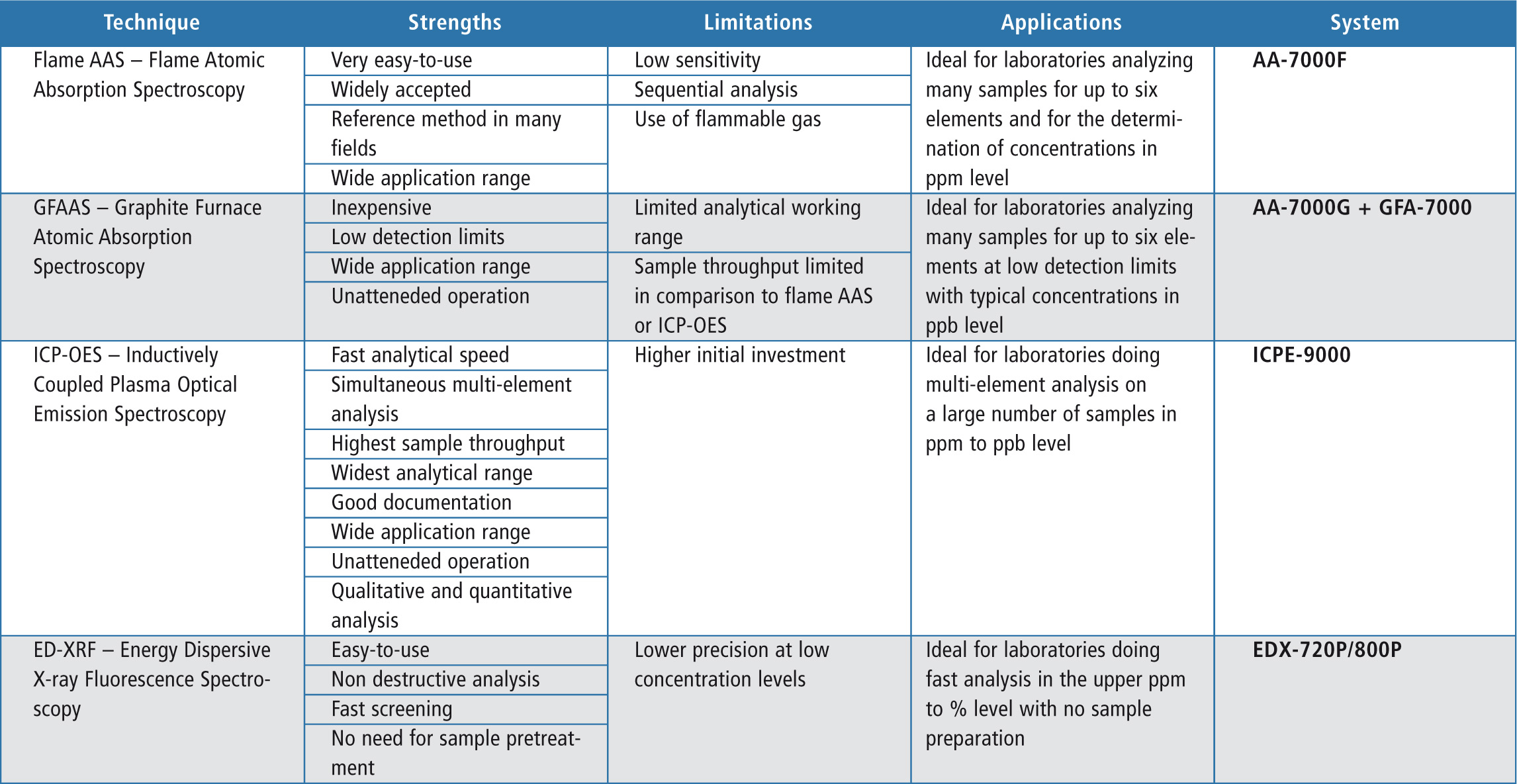The best technique for elemental analysis
Criteria for selection
 Figure 1: Fully automatic atomic absorption spectrometer AA-7000
Figure 1: Fully automatic atomic absorption spectrometer AA-7000
Atomic spectroscopy includes a variety of technologies that are designed primarily for the determination of the elemental composition of samples from many industries, e.g. environmental, geochemical, metallurgical, pharmaceutical, food, agriculture and more. Among these techniques, the most popular ones in routine applications are atomic absorption- (AAS), inductively coupled plasma- (ICP-OES), and X-ray fluorescence- (XRF) spectroscopy.
Which of these techniques for qualitative and quantitative determination of element concentrations is best suited for solving a particular analytical problem? Due to the techniques’ specific strengths and advantages, but also limitations and disadvantages the optimum solution for a particular problem may not always be clear. Selecting the right technique requires consideration of a variety of important criteria such as detection limits, analytical working range, sample throughput, interferences, ease-of-use and the investment budget available. This article gives an overview of the most important techniques and provides the information required to help in selecting the best solution to a specific analytical problem.
Atomic Absorption Spectroscopy
AAS quantitates concentrations of elements in a vapor, when a ground state atom absorbs light energy of a specific wavelength and is elevated to an excited state. The amount of light energy absorbed at this wavelength is increased when the number of atoms of the selected element in the light path increases. The relationship between the amount of light absorbed and the concentration of the element present in known standard solutions can be used to determine unknown sample concentrations by measuring the amount of light they are absorbing.
Quantitative analysis of elements is typically carried out using atomic absorption spectrometers such as the Shimadzu AA-7000, consisting of a primary light source for the target element, an atomization unit, a monochromator to set the specific wavelength of light to be measured, a photomultiplier detector to measure the light, and electronics for the data processing as well as reporting of the results. The light source is a hollow cathode lamp containing the element to be determined in the cathode. The atomization unit is either a burner head for flame atomization or a graphite furnace for electrothermal atomization.
The typical flame system operates a titanium burner head with an air/acetylene or nitrous-oxide/ acetylene flame. The sample is introduced as an aerosol into the flame by the sample-introduction system consisting of a nebulizer with Pt/Ir capillary and a spray chamber which is inert to aqueous and organic solvents. The burner head is aligned so that the light beam passes through the flame, where the light is absorbed. Unfortunately, sample introduction using a nebulizer and spray chamber is not very efficient, so that only a small amount of sample is delivered to the flame, thereby limiting the sensitivity of such system.
In order to improve the sensitivity of atomic absorption spectrometers, another atomization unit is needed consisting of a high sensitivity graphite furnace such as the GFA-7000, where the sample is introduced directly into a graphite tube before it is heated in a programmed sequence to remove the solvent and matrix components and to atomize the element of interest. All of the analyte is atomized, and the residence time of the atoms within the tube is extended resulting in a high sensitivity and significantly improved detection limits in comparison to flame atomization.
 Figure 2: Guide to selecting the right technique
Figure 2: Guide to selecting the right technique
The key differentiator between electrothermal atomization and flame sampling is the analysis time, which is much longer when using the graphite furnace system. On the other hand, the enhanced sensitivity of the graphite furnace which is typically 100 to 1,000 times better than flame makes this an ideal solution for the analysis of ultra low concentrations. Figure 1 shows the AA-7000 which is a fully automatic double beam dual atomizer system in combination with the graphite furnace GFA-7000 with digital control and the ASC-7000 sample preparation station.
The AA-7000 in the dual atomizer version includes both flame and graphite furnace atomization unit, allowing fully automatic changeover from flame to graphite furnace mode and element-specific optimization of the atomizer position. The system includes two methods of background correction for the determination of element concentrations in samples with complex matrices. The Deuterium background correction is useful for compensation of spectral interferences generated by molecular absorption and particulate caused scattering. In addition, the high speed self-reversal technique (high current pulse technique) is useful for compensation of interferences caused by overlapping absorption lines and structured background.
ICP-OES: Inductively Coupled Plasma Optical Emission Spectroscopy
Inductively coupled plasma optical emission spectroscopy (ICP-OES) is the measurement of light emitted by all elements present in a sample introduced into an ICP source. The emission intensities measured are then compared with the intensities of standard samples of known concentration to obtain the elemental concentrations in the unknown samples. The argon plasma is generated by an RF field and ionized argon gas. The advantage of the plasma in comparison to other energy sources is the high temperature of 10,000 K, enabling complete atomization of the elements in a sample while minimizing interferences.
The ICPE-9000 applies a minitorch with reduced argon consumption which is mounted in a vertical position. This setup allows two ways of viewing the light emitted from the torch. In the typical ICP-OES configuration, the light across the plasma is viewed axially from the top, resulting in the highest sensitivity. In radial view from the side, the sensitivity is reduced by a factor of 5 to 10. The most effective way of operation allows the plasma to be viewed in either orientation in a single analysis, providing the best detection capabilities and the widest working range, the so called dual view mode.
The vacuum optical system of ICPE-9000 consists of a spectrometer including a diffraction grating and a prism for separation of the individual wavelengths of light and focusing onto the surface of the large CCD detector (Charge- Coupled Device). This setup allows true simultaneous multi element analysis with highest sample throughput. In addition to quantitative measurements against calibration curves of standard samples, the system also enables qualitative analysis.
 Table 1: Overview of strengths and limitations
Table 1: Overview of strengths and limitations
X-ray Fluorescence Spectroscopy (XRF)
XRF allows analysis of element composition of samples in a wide variety of applications. This technique provides non-destructive and fast measurements of liquid and solid samples and is best suited for analyzing the elemental range from sodium/carbon to uranium, which covers the majority of the metallic elements.
In a typical energy dispersive XRF-spectrometer such as EDX-720P/800P, the tube directs X-rays onto the sample, ejecting electrons from the inner electron shells of the atoms. When outer electrons fill in the hole left by the ejected electron, energy is emitted as X-rays and measured on the detector of the XRF spectrometer. The strength of the signal from each element reveals the relative concentration in the sample. Energy dispersive XRF spectrometers such as EDX-720P/800P are multi-purpose instruments for quantitative analysis using standard samples for calibration with high accuracy, as well as the fundamental parameter method when standard samples are not available. Simultaneous screening in the elemental range from sodium/carbon to uranium is also possible.
Shimadzu is one of the worldwide leading manufacturers of analytical instrumentation and has been setting milestones in the field of atomic spectroscopy for more than 40 years. With a state of the art product line ranging from flame atomic absorption and high performance graphite furnace atomic absorption to simultaneous ICP-OES- and X-ray fluorescence systems, Shimadzu offers a total hardware and software solution for the determination of element concentrations in every type of sample.